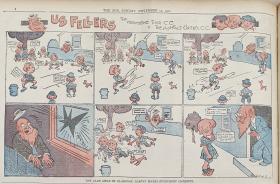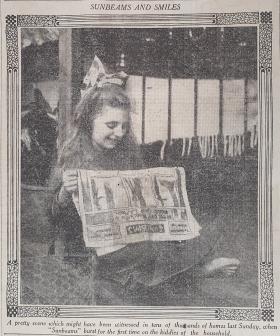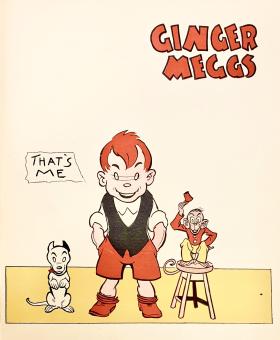Happy 100th birthday Ginger!
Creators come and go but their characters live on. When I pass on, I hope the character I have created in Ginger will live long beyond me — JC Bancks, 1951
Ginger Meggs, Australia’s longest running comic strip character and national icon, burst to life on 13 November 1921 in the first issue of the Sunbeams colour comic supplement for Sydney’s Sunday Sun. One of a gang of cricket-playing characters created by cartoonist James ‘Jimmy’ Bancks for the ‘Us Fellers’ comic strip, the red headed, 11-year-old ‘Ginge’ made only a brief appearance that day. The next day, reporting on the success of the Sun’s colour printing experiment, the paper stated:
wherever children congregated they were to be seen scanning the contents with chuckles of delight … And it was not only the kiddies who enjoyed the pictures.


A few days later, she met with JC Bancks, ‘a young man with a shy yet eager manner and eyes with a glint of laughter in them’. Seeing his preliminary sketches of Ginger on a billy cart, falling into a pond and fishing, she asked the cartoonist how he knew so much ‘about small boys and their haunts and habits’. ‘Well,’ he said modestly, ‘I rather like boys and … where I live I often watch them from my window racing their billy carts down the hill after school. Great fun they are. I used to have a billy cart myself once …’
The plot of the ‘Us Fellers’ strip had initially revolved round the activities of Gladsome Gladys, a sweet and pretty little girl whose larrikin friends used her charms to get them out of awkward jams. But Bancks tired of Gladys and dropped her a few months later to focus on a boy who’d only been a minor character until then.
As The Sunbeams supplement was printed in colour, with only a limited range of inks available — blue, red and yellow — Bancks had given the boy red hair and christened him Ginger Smith. By April 1922, Ginger had the new surname ‘Meggs’, but the strip would be known as ‘Us Fellers’ for another 18 years. It was not until November 1939 that the ‘Ginger Meggs’ banner officially took over.
Bancks said his own family was ‘a living comic strip’, and the adventures of Ginger Meggs were modelled on the artist's life as a boy. Growing up in the semi-rural Sydney suburb of Hornsby, Bancks recalled having an unremarkable but highly enjoyable childhood with all the delights of cricket, football and swimming holes.
In creating the Meggs family, Bancks created characters who not only amused Australians but stirred affection in everybody who read about them. Fusspot father John, purposeful mother Sarah, little brother Dudley, faithful dog Mike, best mate Benny and girlfriend Minnie Peters — along with Ginger’s enemies Eddie Coogan and Tiger Kelly — were familiar figures in almost every Australian home and in homes scattered over many parts of the globe.
Bancks drew the ‘Ginger Meggs’ strip for nearly 31 years and, at the time of this sudden death in July 1952, had a year’s supply of strips already prepared. This gave time for his successor to be found, and each artist since Bancks has made a long term commitment to drawing the little Aussie lad: Ron Vivian (1953–73); Lloyd Piper (1973–84); James Kemsley (1984–2007) and Jason Chatfield (2007–).
Along with the responsibility for staying true to the comic’s original ideals and upholding Ginger’s larrikin spirit, came the challenge of keeping him relevant to contemporary life. Ginger had crossed the Sydney Harbour Bridge when it opened in 1932 and met cricketing great Don Bradman. His pet monkey, Tony — who joined the strip for a couple of weeks in 1934 and remained due to reader demand — travelled to the moon in the 1960s. Having adjusted to radio and television, in the 1980s Australia’s favourite boy got an Xbox and a Gameboy.
Today ‘Ginger Meggs’ appears in more than 120 newspapers in 34 countries and remains Australia’s most widely syndicated comic strip. It’s peopled by a gang of characters who represent the cultural diversity of Australia in the 21st century. Ginger wears a T-shirt and trainers and carries a mobile phone. His adventures are also published online and via an app, and seen on Instagram and Twitter.
Ginger speaks to the eternal child and larrikin spirit in us all. He’s a little Aussie battler from an average suburban family — testing authority to its limits but always taking life’s knocks on the chin, picking himself up when he falls and laughing at himself. Happy Birthday Ginge!
